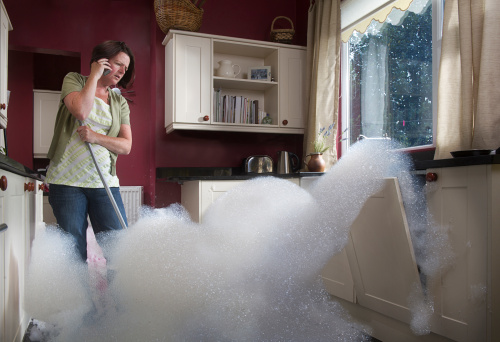
Don't let this happen to you!
(Photo: Getty Images/sturti)
Surprises can be fun, but not when they involve breakdowns, costly repairs, and big bills from plumbers or electricians. Here are some simple ways to avoid making costly mistakes with your appliances, according to AppliancePartsPros.com, an online retailer serving the fix-it-yourselfer.
Not Monitoring Interior Temperature of Your Refrigerator or Cleaning Condenser
Keeping an inexpensive thermometer inside your refrigerator can save you money on spoiled food and needless electricity. If it's too warm inside, your food will spoil. If it's too cold, you're wasting money on unnecessary electricity. Refrigerator temperature should be no higher than 40 degrees Farenheit, and freezer temperature should be zero degrees Farenheit. Food-borne illnesses can result from the food spoilage and bacteria can grow especially rapidly between 40 and 140 degrees. And, of course, during a power failure, a thermometer is a must to determine whether your food is safe to eat. Also, if your refrigerator's condenser gets clogged with dust and dirt, that forces the refrigerator to work harder and use more electricity. Save money and wear and tear on your refrigerator by cleaning its condenser every six months with a vacuum cleaner or condenser brush.
Jamming Your Garbage Disposer
You could pay $400 for a new garbage disposer, including installation costs. Why not keep yours running smoothly for years by taking good care of it and keeping its blades free of obstruction? Keep these out of it: grease, oil, celery, corn husks, shells, bones, and coffee grounds. If it jams, clear it this way:
Unplug it. If it's hardwired, turn power off at the service panel.
Insert allen wrench into bottom center hole on machine and rotate until it moves freely. If disposer didn't come with a wrench, insert a wooden broomstick or plunger handle into mouth of the disposer to move blades. Never use your hands.
Using a needle-nose pliers or tongs, remove from the disposer's mouth whatever is jamming the blades.
Reconnect power. If it doesn't power up and it has a reset button on unit's bottom, ensure unit is cool to the touch, then press the button.
If disposer still won't start, repeat above process twice before calling service technician.
Using the Wrong Soap in Your Dishwasher
A typical kitchen nightmare might be a soapy water flood on your kitchen floor caused by mistakenly filling your dishwasher's soap container with dish detergent, regular liquid soap, or some other soap not specifically intended for the dishwasher. Which explains why you could find the soap pouring out of your dishwasher like it was some hyperactive bubble machine. First, remove the dish racks and dishes and wash them by hand. Scoop out as much of the excess water and suds as possible. Add 1-2 cups of white vinegar to the dishwasher, along with some ice cubes. Run the dishwasher for a full cycle. The ice will lower the water temperature, cutting down on the foaming. The vinegar will also cut down on the foaming. Running the cycle again may be necessary since soapy water may remain within the hoses and the pump.
Overloading and Not Protecting Your Washing Machine
As careful as you are with your washing machine, you can easily burn out your washer's delicate high-tech controls and digital displays and it won't even result from something you did. How? A lightning strike could knock out your neighborhood transformer. Solution: Plug your washer into a surge protector instead of directly into a power supply, to protect its electric circuit boards. Be careful, though, not to place the surge protector on the ground, where it might get wet. As for overloading your machine, keep in mind that it's not a Thanksgiving turkey into whose cavity you need to cram as much as possible. Doing so will put a big strain on your machine's inner workings, such as bearings and suspension. Recommended fill capacity for your machine should be stated in its instruction manual or inside the lid of top-loading washers.
Not Keeping Your Dryer Lint-Free
Most of us know to clean the lint trap before or after using the dryer each time. But you should also clean the vent hose at the back of the dryer every six months. Lint is extremely flammable and if your dryer vent becomes clogged with it and unable to effectively vent the hot air, the resulting heat build-up could cause the lint to catch fire. If your dryer is located close to an outside wall, its duct work could be short enough to give you access to cleaning it. Disconnect power to the machine. Use a vent-cleaning brush. If the duct work is quite lengthy, however, consider calling a professional. Clean the vent outside your home, too, to ensure the escaping hot air is not being impeded by an accumulation of dust and debris. Fires often result from an accumulation of lint inside the dryer cabinet itself. For most dryers, such as Whirlpools, this will involve first, as always, disconnecting the power to the machine. Remove the lint screen screws, inserting a putty knife 2-3 inches on either front corner of the machine in the indentation between the top and the main unit, press knife in and lift up on corners to undo the release clips. When top is off, remove front panel screws with a socket or nut driver. Disconnect the door switch, lift front panel off the dryer to allow you to vacuum the area between the dryer drum and the cabinet. While vacuuming, take care not to pull out any wires or disturb the igniter, which is near the gas valve. Replace everything when done.